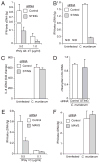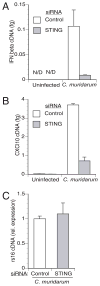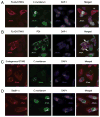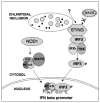Stimulator of IFN gene is critical for induction of IFN-beta during Chlamydia muridarum infection
- PMID: 20107183
- PMCID: PMC2863030
- DOI: 10.4049/jimmunol.0903704
Stimulator of IFN gene is critical for induction of IFN-beta during Chlamydia muridarum infection
Abstract
Type I IFN signaling has recently been shown to be detrimental to the host during infection with Chlamydia muridarum in both mouse lung and female genital tract. However, the pattern recognition receptor and the signaling pathways involved in chlamydial-induced IFN-beta are unclear. Previous studies have demonstrated no role for TLR4 and a partial role for MyD88 in chlamydial-induced IFN-beta. In this study, we demonstrate that mouse macrophages lacking TLR3, TRIF, TLR7, or TLR9 individually or both TLR4 and MyD88, still induce IFN-beta equivalent to wild type controls, leading to the hypothesis that TLR-independent cytosolic pathogen receptor pathways are crucial for this response. Silencing nucleotide-binding oligomerization domain 1 in HeLa cells partially decreased chlamydial-induced IFN-beta. Independently, small interfering RNA-mediated knockdown of the stimulator of IFN gene (STING) protein in HeLa cells and mouse oviduct epithelial cells significantly decreased IFN-beta mRNA expression, suggesting a critical role for STING in chlamydial-induced IFN-beta induction. Conversely, silencing of mitochondria-associated antiviral signaling proteins and the Rig-I-like receptors, RIG-I, and melanoma differentiation associated protein 5, had no effect. In addition, induction of IFN-beta depended on the downstream transcription IFN regulatory factor 3, and on activation of NF-kappaB and MAPK p38. Finally, STING, an endoplasmic reticulum-resident protein, was found to localize in close proximity to the chlamydial inclusion membrane during infection. These results indicate that C. muridarum induces IFN-beta via stimulation of nucleotide-binding oligomerization domain 1 pathway, and TLR- and Rig-I-like receptor-independent pathways that require STING, culminating in activation of IFN regulatory factor 3, NF-kappaB, and p38 MAPK.
Conflict of interest statement
The authors have no financial conflicts of interest.
Figures









Similar articles
-
Role of adaptor TRIF in the MyD88-independent toll-like receptor signaling pathway.Science. 2003 Aug 1;301(5633):640-3. doi: 10.1126/science.1087262. Epub 2003 Jul 10. Science. 2003. PMID: 12855817
-
The Chlamydia muridarum-induced IFN-β response is TLR3-dependent in murine oviduct epithelial cells.J Immunol. 2010 Dec 1;185(11):6689-97. doi: 10.4049/jimmunol.1001548. Epub 2010 Oct 25. J Immunol. 2010. PMID: 20974982
-
Intracellular bacterial infection-induced IFN-gamma is critically but not solely dependent on Toll-like receptor 4-myeloid differentiation factor 88-IFN-alpha beta-STAT1 signaling.J Immunol. 2004 May 15;172(10):6345-53. doi: 10.4049/jimmunol.172.10.6345. J Immunol. 2004. PMID: 15128825
-
Analyses of the pathways involved in early- and late-phase induction of IFN-beta during C. muridarum infection of oviduct epithelial cells.PLoS One. 2015 Mar 23;10(3):e0119235. doi: 10.1371/journal.pone.0119235. eCollection 2015. PLoS One. 2015. PMID: 25798928 Free PMC article.
-
Cutting edge: a novel Toll/IL-1 receptor domain-containing adapter that preferentially activates the IFN-beta promoter in the Toll-like receptor signaling.J Immunol. 2002 Dec 15;169(12):6668-72. doi: 10.4049/jimmunol.169.12.6668. J Immunol. 2002. PMID: 12471095
Cited by
-
Sensing the enemy, containing the threat: cell-autonomous immunity to Chlamydia trachomatis.FEMS Microbiol Rev. 2016 Nov 1;40(6):875-893. doi: 10.1093/femsre/fuw027. FEMS Microbiol Rev. 2016. PMID: 28201690 Free PMC article. Review.
-
Detection of a microbial metabolite by STING regulates inflammasome activation in response to Chlamydia trachomatis infection.PLoS Pathog. 2017 Jun 1;13(6):e1006383. doi: 10.1371/journal.ppat.1006383. eCollection 2017 Jun. PLoS Pathog. 2017. PMID: 28570638 Free PMC article.
-
Role of STAT1 in Chlamydia-Induced Type-1 Interferon Production in Oviduct Epithelial Cells.J Interferon Cytokine Res. 2015 Nov;35(11):901-16. doi: 10.1089/jir.2015.0013. Epub 2015 Aug 11. J Interferon Cytokine Res. 2015. PMID: 26262558 Free PMC article.
-
Human genetic diversity regulating the TLR10/TLR1/TLR6 locus confers increased cytokines in response to Chlamydia trachomatis.HGG Adv. 2021 Nov 25;3(1):100071. doi: 10.1016/j.xhgg.2021.100071. eCollection 2022 Jan 13. HGG Adv. 2021. PMID: 35047856 Free PMC article.
-
Plasmid-mediated virulence in Chlamydia.Front Cell Infect Microbiol. 2023 Aug 17;13:1251135. doi: 10.3389/fcimb.2023.1251135. eCollection 2023. Front Cell Infect Microbiol. 2023. PMID: 37662000 Free PMC article. Review.
References
-
- Xia M, Bumgarner RE, Lampe MF, Stamm WE. Chlamydia trachomatis infection alters host cell transcription in diverse cellular pathways. J Infect Dis. 2003;187:424–434. - PubMed
-
- Rasmussen SJ, Eckmann L, Quayle AJ, Shen L, Zhang YX, Anderson DJ, Fierer J, Stephens RS, Kagnoff MF. Secretion of proinflammatory cytokines by epithelial cells in response to Chlamydia infection suggests a central role for epithelial cells in chlamydial pathogenesis. J Clin Invest. 1997;99:77–87. - PMC - PubMed
-
- Ren Q, Robertson SJ, Howe D, Barrows LF, Heinzen RA. Comparative DNA microarray analysis of host cell transcriptional responses to infection by Coxiella burnetii or Chlamydia trachomatis. Ann N Y Acad Sci. 2003;990:701–713. - PubMed
-
- Lad SP, Fukuda EY, Li J, de la Maza LM, Li E. Up-regulation of the JAK/STAT1 signal pathway during Chlamydia trachomatis infection. J Immunol. 2005;174:7186–7193. - PubMed
Publication types
MeSH terms
Substances
Grants and funding
LinkOut - more resources
Full Text Sources
Other Literature Sources
Molecular Biology Databases
Research Materials

